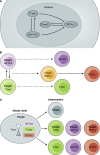Dynamic balance between master transcription factors determines the fates and functions of CD4 T cell and innate lymphoid cell subsets
- PMID: 28630089
- PMCID: PMC5502437
- DOI: 10.1084/jem.20170494
Dynamic balance between master transcription factors determines the fates and functions of CD4 T cell and innate lymphoid cell subsets
Abstract
CD4 T cells, including T regulatory cells (Treg cells) and effector T helper cells (Th cells), and recently identified innate lymphoid cells (ILCs) play important roles in host defense and inflammation. Both CD4 T cells and ILCs can be classified into distinct lineages based on their functions and the expression of lineage-specific genes, including those encoding effector cytokines, cell surface markers, and key transcription factors. It was first recognized that each lineage expresses a specific master transcription factor and the expression of these factors is mutually exclusive because of cross-regulation among these factors. However, recent studies indicate that the master regulators are often coexpressed. Furthermore, the expression of master regulators can be dynamic and quantitative. In this review, we will first discuss similarities and differences between the development and functions of CD4 T cell and ILC subsets and then summarize recent literature on quantitative, dynamic, and cell type-specific balance between the master transcription factors in determining heterogeneity and plasticity of these subsets.
This is a work of the U.S. Government and is not subject to copyright protection in the United States. Foreign copyrights may apply.
Figures




Similar articles
-
Multilayer regulation of CD4 T cell subset differentiation in the era of single cell genomics.Adv Immunol. 2019;141:1-31. doi: 10.1016/bs.ai.2018.12.001. Epub 2019 Jan 3. Adv Immunol. 2019. PMID: 30904130 Review.
-
Co-expression of master transcription factors determines CD4+ T cell plasticity and functions in auto-inflammatory diseases.Immunol Lett. 2020 Jun;222:58-66. doi: 10.1016/j.imlet.2020.03.007. Epub 2020 Mar 24. Immunol Lett. 2020. PMID: 32220615 Review.
-
Transcriptional regulation of adaptive and innate lymphoid lineage specification.Immunol Rev. 2021 Mar;300(1):65-81. doi: 10.1111/imr.12935. Epub 2020 Dec 7. Immunol Rev. 2021. PMID: 33615514 Review.
-
CD4 CTL: living up to the challenge.Semin Immunol. 2013 Nov 15;25(4):273-81. doi: 10.1016/j.smim.2013.10.022. Epub 2013 Nov 15. Semin Immunol. 2013. PMID: 24246226 Free PMC article. Review.
-
Differential regulation of lineage-determining transcription factor expression in innate lymphoid cell and adaptive T helper cell subsets.Front Immunol. 2023 Jan 4;13:1081153. doi: 10.3389/fimmu.2022.1081153. eCollection 2022. Front Immunol. 2023. PMID: 36685550 Free PMC article. Review.
Cited by
-
Multi-Dimensional Gene Regulation in Innate and Adaptive Lymphocytes: A View From Regulomes.Front Immunol. 2021 Mar 25;12:655590. doi: 10.3389/fimmu.2021.655590. eCollection 2021. Front Immunol. 2021. PMID: 33841440 Free PMC article. Review.
-
GATA3, HDAC6, and BCL6 Regulate FOXP3+ Treg Plasticity and Determine Treg Conversion into Either Novel Antigen-Presenting Cell-Like Treg or Th1-Treg.Front Immunol. 2018 Jan 26;9:45. doi: 10.3389/fimmu.2018.00045. eCollection 2018. Front Immunol. 2018. PMID: 29434588 Free PMC article.
-
PD-1 Affects the Immunosuppressive Function of Group 2 Innate Lymphoid Cells in Human Non-Small Cell Lung Cancer.Front Immunol. 2021 Jun 14;12:680055. doi: 10.3389/fimmu.2021.680055. eCollection 2021. Front Immunol. 2021. PMID: 34194433 Free PMC article.
-
Differential Expression of the Transcription Factor GATA3 Specifies Lineage and Functions of Innate Lymphoid Cells.Immunity. 2020 Jan 14;52(1):83-95.e4. doi: 10.1016/j.immuni.2019.12.001. Epub 2019 Dec 24. Immunity. 2020. PMID: 31882362 Free PMC article.
-
Single cell transcriptomics in a treatment-segregated cohort exposes a STAT3-regulated therapeutic gap in idiopathic pulmonary fibrosis.bioRxiv [Preprint]. 2025 Jun 21:2025.06.16.659944. doi: 10.1101/2025.06.16.659944. bioRxiv. 2025. PMID: 40666833 Free PMC article. Preprint.
References
Publication types
MeSH terms
Substances
Grants and funding
LinkOut - more resources
Full Text Sources
Other Literature Sources
Research Materials

